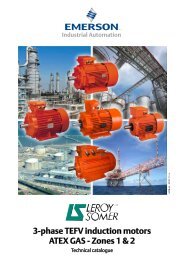Catalogue
Catalogue
Catalogue
Create successful ePaper yourself
Turn your PDF publications into a flip-book with our unique Google optimized e-Paper software.
16<br />
2. b)<br />
Voltage and frequency limits<br />
CEG three-phase motors, matching IEC 72-1 requirements and designed to run at 230/400V, will provide their rated<br />
output when 50Hz rated frequency is applied by a voltage that may vary between ± 5%. A further tolerance of ± 5%<br />
on extreme values is allowable, but performances within this variation will not necessarily be in accordance with the<br />
ones at rated voltage.<br />
They can run at 60Hz too and in this case performances will vary as described in the following table:<br />
Voltage at 60 Hz<br />
220/380 Volt<br />
230/400 Volt<br />
240/415 Volt<br />
255/440 Volt<br />
265/460 Volt<br />
280/480 Volt<br />
Pn<br />
1<br />
1<br />
1,05<br />
1,15<br />
1,15<br />
1,2<br />
(*) Ratio referred to rated torque at 60Hz<br />
Voltages not shown are available on request.<br />
Operating conditions (IEC 34 - 1)<br />
Chart 3: Voltage and frequency limits<br />
Motors with nominal voltage 230/400 V 50 Hz<br />
Mn<br />
0,83<br />
0,83<br />
0,87<br />
0,93<br />
0,96<br />
1<br />
Rpm Is/In Ms/Mn* Mm/Mn*<br />
1,2 0,83 0,83 0,83<br />
1,2 0,83 0,83 0,83<br />
1,2 0,87 0,87 0,87<br />
1,2 0,93 0,93 0,93<br />
1,2 0,96 0,96 0,96<br />
1,2<br />
1 1 1<br />
Duty<br />
Duty represents the relationship between the operating and rest times or the repeatable operation at different loads,<br />
including starting, electrical braking and no-load running.<br />
Basic duty type for motors designed according to IEC 72-1 is the S1 continuous.<br />
• S1: Continuous Duty: continuous operation at load over sufficient time for thermal equilibrium to be reached.<br />
• S2: Short Time Duty: allows a sufficient rest period between constant load operations for the motor to cool<br />
down at medium temperature.<br />
• S3: Intermittent Periodic Duty*: sequence of identical duty cycles, each including a period of constant load<br />
operation and a rest period. Starting current doesn’t not effect the temperature rise. Maximum operating time<br />
to be specified.<br />
• S4: Intermittent Periodic Duty* with starting: sequence of identical duty cycles at constant load, each<br />
including a significant starting period.<br />
• S5: Intermittent Periodic Duty* with influence of running-up periodic and electrical braking: sequence<br />
of identical duty cycles at constant load, each including a significant starting period and a period of rapid<br />
electric braking.<br />
• S6: Continuous Operation Periodic Duty*: sequence of identical duty cycles each consisting of a period<br />
of operation at constant load and a period of no-load operation without no rest and de-energized intervals.<br />
• S7: Continuous Operation Periodic Duty* with starting and electrical braking: sequence of identical duty<br />
cycles each consisting of a period of operation at constant load including starting and electrical braking<br />
intervals.<br />
• S8: Continuous Operation Periodic Duty* with related Load/Speed variations: sequence of identical duty<br />
cycles at constant load and frequently changing speeds (double pole motors).<br />
• S9: Continuous Operation Duty with Non-Periodic Load and Speed variations: duty in which the load<br />
and the speed vary non-periodically within the permissible range. This duty includes frequently overloads that<br />
may exceed the full load.<br />
• S10: Duty with discrete constant loads: sequence of no more than four different load values each applied<br />
for enough time to let thermal equilibrium to be reached. Minimum no-load value can be included.<br />
(*) No thermal equilibrium reached during the load time.



